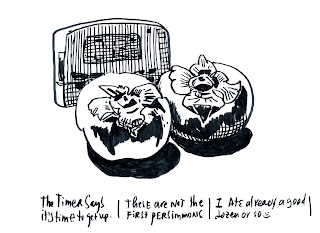When the new school year started last fall my kid began to learn Spanish - and I decided to learn with him.
I am interested in how people learn in general - so whenever someone is ready to talk about it I jump on that topic - and if you have good recommendations for books and sites - please send me links!
One of the things I've been trying with my learning is try a
project based learning process (I loved
this book and
follow it's author -
Lori Pickert-
on Twitter for inspiration). The idea is that you don't follow curriculum that someone created but rather you find a real world project and make it happen with whatever means that are available to you and while you are doing that you are bound to learn a variety of things.
So I decided that I will pursue my study of Spanish utilizing what I enjoy - drawing in my sketchbook. And that is how I've been making slow but steady progress on my vocabulary.
I've created a little character and it's adventured paired with my knowledge of other languages help me remember. I am also doing some Duolingo time and getting briefs on different subjects (grammar and such) from my kid. So far I've drawn over 50 pages and enjoy the process a lot!
Like with every project (and learning in particular) there are ups and downs and after whole 30 days of doing Inktober with these I took a little break and had hard time restarting the practice - but like with everything - by starting small and JUST STARTING - I got back on my horse - or should I say caballo?
Here is a screenshot of a whole bunch of the images and
link to a Flickr folder where you can see all of them.
I've made a whole bunch of new friends on social media while posting these on
Instagram and in general try to keep a two-a week pace now - feel free to follow along
#learningspanishwithsketchook





























